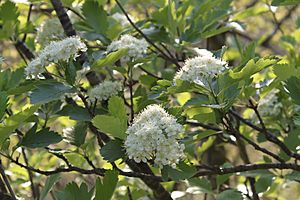Sorbus leyana facts for kids
Quick facts for kids Sorbus leyana |
|
|---|---|
 |
|
| Conservation status | |
| Scientific classification | |
| Genus: |
Sorbus
|
| Species: |
leyana
|
Sorbus leyana, also known as Ley's whitebeam, is a special kind of small tree. It is only found in two places in southern Wales. Scientists believe it grew from two different types of Sorbus trees mixing together. One of these was the rowan tree. Its closest family members are other Sorbus trees in Britain that also came from a mix of species.
Contents
What Ley's Whitebeam Looks Like
Ley's whitebeam is a small tree or a large bush. In the wild, it can grow up to 10 metres (33 ft) tall. If people grow it in gardens, it might get even taller.
The best way to tell Ley's whitebeam apart from similar trees is by looking at its leaves. The side leaves, which grow in a circle (like a rose), are usually about 6.5 centimetres (2.6 in) long and 4.57 centimetres (1.80 in) wide. This means they are about 1.2 to 1.65 times longer than they are wide.
These leaves are widest in the middle. They have deep cuts or "lobes" that go almost three-quarters of the way to the main vein. The edges of the leaves are toothed, like a saw. Each leaf usually has 7 to 10 pairs of veins.
The berries of Ley's whitebeam are wider than they are long. They are a bit wider below the middle. They have a few tiny spots on them. When the berries are ripe, they turn a bright blood-red color.
Where Ley's Whitebeam Lives
Ley's whitebeam has only been found in two places in the wild. Both spots are in the Brecon Beacons area, near Merthyr Tydfil in Wales. These two places are called Darren Fach and Penmoelallt.
These two groups of trees are about 1 kilometre (0.62 mi) apart. In total, there are only about 20 Ley's whitebeam trees left in the world.
Where Ley's Whitebeam Grows
Ley's whitebeam trees grow in areas with bushes or open woodlands. They like rocky cliffs made of Carboniferous limestone. These trees need a lot of sunlight to grow well.
This tree reproduces in a special way called apomixis. This means it can make seeds without needing pollen from another tree. However, it usually produces only a few berries. The seeds from these berries do not often grow into new trees. This is why not many new Ley's whitebeam trees grow naturally. On average, only about 24% of the pollen it makes is able to help new plants grow.
How Ley's Whitebeam Was Found
A clergyman and botanist (a plant scientist) named Reverend Augustin Ley discovered this tree in the 1800s. Later, Alfred James Wilmott named the tree Sorbus leyana in his honor.
Scientists think Ley's whitebeam came from a mix of the rowan tree and another type of whitebeam. This other tree was either the grey whitebeam (S. rupicola) or the grey whitebeam (S. porrigentiformis).
Ley's whitebeam belongs to a group of similar Sorbus trees. These trees all have deeply cut leaves and small fruits. Other trees in this group include the English whitebeam (S. anglica), the least whitebeam (S. minima), and the Arran whitebeam (S. arranensis).
Protecting Ley's Whitebeam
Ley's whitebeam is only found in two places. Both of these places are protected as a Site of Special Scientific Interest. The Darren Fach site is also part of the Wildlife Trust of South & West Wales reserve called Darren Fawr.
Forester Peter Charlesworth "rediscovered" these trees in the 1950s. After that, new trees were grown from them at the National Botanic Garden of Wales.
This tree is in danger because animals eat its leaves and branches. Taller trees also block its sunlight. For new Ley's whitebeam trees to grow, they really need access to light.


